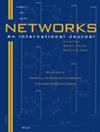列车编组和运输路径优化问题的两个新的混合整数规划模型
IF 1.3
4区 计算机科学
Q4 COMPUTER SCIENCE, HARDWARE & ARCHITECTURE
引用次数: 1
摘要
铁路车辆被称为货运铁路运输业的心脏。因此,他们运营的任何改进都可以大幅降低各种运营成本。轨道车最关键的操作之一是阻塞和安排运输路线。铁路公司面临着持续的挑战,即应形成哪些区块来运送不同始发地-目的地对(O–D对)的货物,并在中间堆场对其进行重新分类,以最大限度地降低运输重新分类成本。此外,有必要确定O–D对之间的列车服务和列车数量。与运输路线计划一起,这个问题被称为列车编组和运输路径优化(TFSP)。在TFSP中,应考虑一些子结构和铁路网的运营约束,包括链路容量、分类容量、分拣轨道数量和路径长度。本文提出了两个基于圆弧的混合整数线性规划(MILP)模型来公式化TFSP问题。据作者所知,对于解决之前不需要任何预处理的问题,尚未发布基于MILP弧的模型。在数据集上求解模型的计算结果表明,第一个模型可以在48码的情况下获得最大间隙为0.05%的可行解。对于高达128码的情况,第二个模型也可以在合理的时间内找到与最佳解决方案相比差距较小的解决方案。同时,将所提出的模型与文献中的最佳方法进行了比较,并表明了它们的优越性。本文章由计算机程序翻译,如有差异,请以英文原文为准。
Two new mixed‐integer programming models for the integrated train formation and shipment path optimization problem
Railcars are known as the heart of the freight rail transportation industry. Hence, any improvements in their operations can lead to sharp reductions in various operating costs. One of the most critical operations on railcars is blocking and routing their transportation. Railway companies face continuous challenged about what blocks should be formed to carry shipments across different origin–destination pairs (O–D pairs) and reclassify them in intermediate yards to minimize transportation reclassification costs. In addition, it is necessary to determine train service between O–D pairs and the number of trains. Along with the shipment routing plans, this problem is called train formation and shipment path optimization (TFSP). In TFSP, some substructure and rail network operational constraints should be considered, including link capacity, classification capacity, the number of sorting tracks, and path length. This paper presents two arc‐based mixed‐integer linear programming (MILP) models to formulate the TFSP problem. To the best of the authors' knowledge, no MILP arc‐based model has been published for the problem that does not need any preprocess before solving. Computational results of solving models on the datasets showed that the first model could obtain a feasible solution with a maximum 0.05% gap up to 48 yards instance. The second model also could find a solution with a small gap compared to the optimal solution in a reasonable time for instances up to 128 yards. Also, the proposed models were compared to the best methods in the literature, and their superiority was shown.
求助全文
通过发布文献求助,成功后即可免费获取论文全文。
去求助
来源期刊

Networks
工程技术-计算机:硬件
CiteScore
4.40
自引率
9.50%
发文量
46
审稿时长
12 months
期刊介绍:
Network problems are pervasive in our modern technological society, as witnessed by our reliance on physical networks that provide power, communication, and transportation. As well, a number of processes can be modeled using logical networks, as in the scheduling of interdependent tasks, the dating of archaeological artifacts, or the compilation of subroutines comprising a large computer program. Networks provide a common framework for posing and studying problems that often have wider applicability than their originating context.
The goal of this journal is to provide a central forum for the distribution of timely information about network problems, their design and mathematical analysis, as well as efficient algorithms for carrying out optimization on networks. The nonstandard modeling of diverse processes using networks and network concepts is also of interest. Consequently, the disciplines that are useful in studying networks are varied, including applied mathematics, operations research, computer science, discrete mathematics, and economics.
Networks publishes material on the analytic modeling of problems using networks, the mathematical analysis of network problems, the design of computationally efficient network algorithms, and innovative case studies of successful network applications. We do not typically publish works that fall in the realm of pure graph theory (without significant algorithmic and modeling contributions) or papers that deal with engineering aspects of network design. Since the audience for this journal is then necessarily broad, articles that impact multiple application areas or that creatively use new or existing methodologies are especially appropriate. We seek to publish original, well-written research papers that make a substantive contribution to the knowledge base. In addition, tutorial and survey articles are welcomed. All manuscripts are carefully refereed.
 求助内容:
求助内容: 应助结果提醒方式:
应助结果提醒方式:


